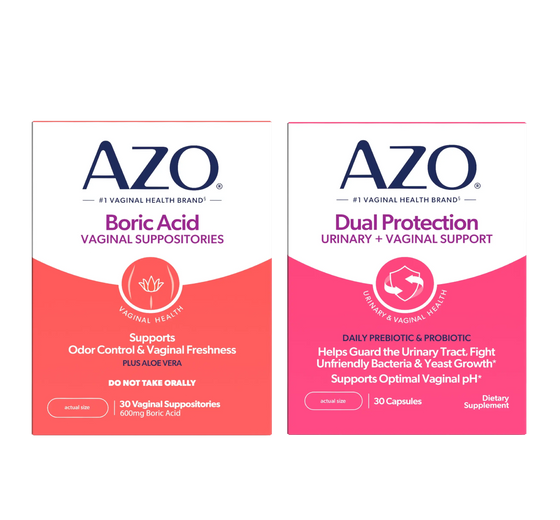
From A to Z(O), learn the language of your body.
The first step in good health is understanding your body—what it wants, how to feel your best, and how to make the right choices when you’re not feeling so hot. Become skilled with our breakdown of terminology.
Antibacterial Protection – An agent that prevents the growth and reproduction of bacteria.
Ashwagandha root and leaf – an Ayurvedic herb that can provide mood support and reduce stress during hormonal fluctuations of a woman’s menstrual cycle.
Bladder Leakage (Occasional) – An unintentional loss of urine as a result of pressure on the bladder from physical (or normal) activities like coughing, sneezing, jumping or running.
Candida albicans – A fungus, or type of yeast, naturally present in the vagina that can cause vaginal infections when in overabundance. Also referred to as vaginal candidiasis, monilial vaginitis, and vaginal thrush.
Chaste Tree Berry – originating from the Mediterranean, Chaste Tree Berry is a plant that has been used for thousands of years to support hormonal health.
Cranberry – Small, red berries renowned for their antioxidant and anti-adhesion health benefits and commonly used to maintain a healthy urinary tract.
Escherichia coli (E. coli) – A type of bacteria that lives inside the intestines and is responsible for 90% of urinary tract infections (UTIs).
Estrogen – the primary female sex hormone. During a woman’s menstrual cycle, estrogen produces a suitable environment for the fertilization of an egg.
Follicular phase – starts on the first day of menstruation and ends with ovulation. During this phase, estrogen levels rise as an egg prepares to be released.
Hormones – hormones are your body’s chemical messengers. They help to relay messages between cells and organs and affect bodily functions. The main female sex hormones that impact your cycle are estrogen and progesterone. These hormones fluctuate during the menstrual cycle, causing physical and emotional symptoms in some women.
Lactobacillus – The genus of beneficial bacteria most commonly found in the vagina.
Leukocytes – The technical term for “white blood cells.” If present in the urine, can be an indicator of a urinary tract infection (UTI).
Loss of Bladder Control (Occasional) – Issues impacting the bladder at times, including bladder leakage, frequency of urination, and urgency.
Luteal phase – starts after ovulation. The ovaries produce progesterone and the uterus prepares for a fertilized egg to implant. If the egg is not fertilized (sperm is needed to fertilize the egg), it passes through the uterus and the next menstrual period begins.
Menopause – Reproductive shift marked by cessation of menstruation and reduced estrogen levels.
Menstrual cycle – the approximately 28-day hormonal process a woman’s body goes through each month to prepare for a possible pregnancy. The phases that make up the menstrual cycle are the follicular phase in which menstruation occurs and the luteal phase in which ovulation occurs.
Menstruation – each month, a woman’s body prepares for pregnancy and when no pregnancy occurs, the uterine lining sheds—resulting in vaginal bleeding, also known as a period.
Nitrates – A form of nitrogen that when present in the urine could be an indicator of a urinary tract infection (UTI).
Overactive Bladder (OAB) – A condition that can only be diagnosed and treated by your doctor when experiencing extreme loss of bladder control.
Ovulation – the release of an egg during menstruation.
Premenstrual syndrome (PMS) – a combination of physical and emotional symptoms that many women experience about a week or two before the onset of menstruation. These include but are not limited to irritability, appetite changes, bloating and breast soreness.
Probiotics – Live bacteria strains that encourage the colonization and growth of “good” bacteria within the body. Though most commonly associated with gut health, clinical studies link probiotics to health benefits well beyond the gut—from supporting vaginal health, maintaining healthy blood pressure, even helping support healthy skin.1
Probiotics for Vaginal Health – Supplement that encourages the colonization of good bacteria within the vagina and helps maintain a healthy vaginal pH.*
Progesterone – a female hormone. After ovulation, the ovaries start to produce progesterone needed by the uterus. Progesterone causes the uterine lining to thicken, creating an ideal environment to fertilize an egg.
Urinary Incontinence – A regular pattern of uncontrolled leakage of urine only diagnosed and treated by a doctor or medical professional. Though it affects both men and women, it is twice as common in women and can cause high levels of distress that impact quality of life.
Urinary Tract Infection (UTI) – An infection anywhere in the urinary tract, such as the kidneys, bladder and urethra, typically caused when bacteria, often E. coli, enters the urethra.
Urinary Urgency (occasional) – The sudden and immediate need to go to the bathroom. Can be a symptom of a UTI, but when experienced occasionally outside of a UTI can indicate a separate bladder control issue.
Vaginal Infections – Also known as vaginitis, various conditions that are diagnosed and treated by your doctor that can cause an infection of the vagina often accompanied by itching, burning, occasional odor and discharge.
Vaginal Microbiome – The community of bacteria hosted inside a vagina that serves as a protective barrier against vaginal infections and important to a woman’s health.
Vaginal pH – The scale indicating the alkalinity or acidity of the vagina. In good health, the vagina is acidic 3.8 – 4.5 providing a natural defense against infection and irritation. Above a level of 4.5, the vagina is susceptible to non-beneficial or unfriendly bacteria that can introduce other vaginal issues.
Vaginal Probiotic – See probiotics for vaginal health.
Vulvovaginal Candidiasis – See yeast infection.
Weight Management – Strategies to maintain a healthy weight through a healthy diet and active lifestyle.
Yeast Infection – Also known as, vaginal infection that occurs when there is an overabundance of vaginal yeast. Symptoms include vaginal discharge, itching, irritation, and pain during urination and intercourse. Over the counter medicines are available to treat vaginal yeast infection symptoms. It is recommended that you seek your doctor for diagnosis of an infection and to discuss treatment options.
1 https://www.healthline.com/nutrition/8-health-benefits-of-probiotics








